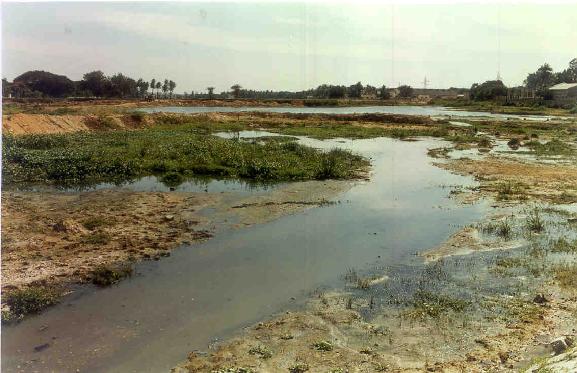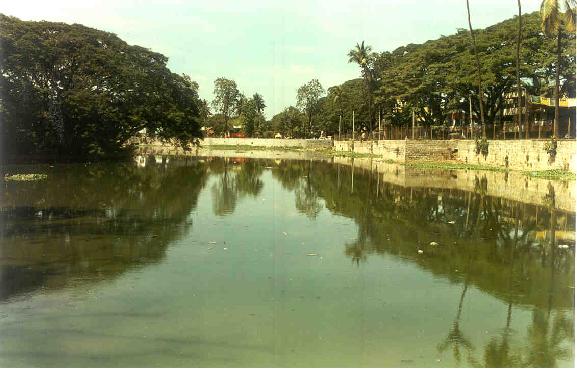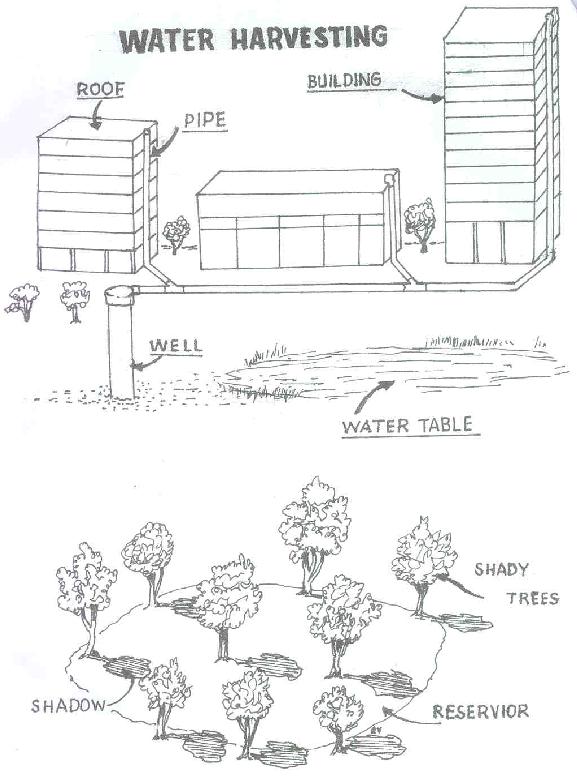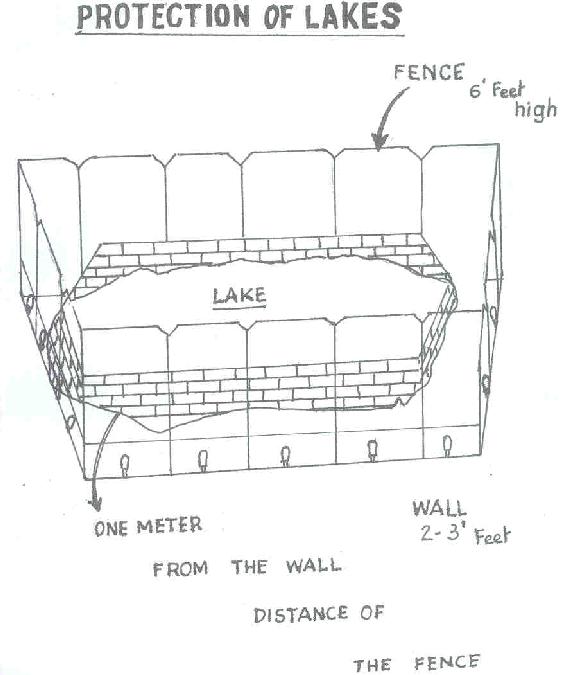
|

|

|

RESTORATION OF LAKES AND WETLANDS
Parul Khare


|

|

|


 ABSTRACT:
ABSTRACT:
 RESTORATION OF LAKES AND WETLANDS:-INTRODUCTION
RESTORATION OF LAKES AND WETLANDS:-INTRODUCTION
 FORMATION OF LAKES
FORMATION OF LAKES
 SIGNIFICANCE OF LAKES
SIGNIFICANCE OF LAKES
 LAKE DEPOSITS - LIFE OF A LAKE
LAKE DEPOSITS - LIFE OF A LAKE
 LAKES OF INDIA
LAKES OF INDIA
 POLLUTION OF LAKES
POLLUTION OF LAKES
 CONTRIBUTION BY MAN
CONTRIBUTION BY MAN
 CONTRIBUTION BY NATURE
CONTRIBUTION BY NATURE
 LAKES OF BANGALORE
LAKES OF BANGALORE
 SATELLITES - MANKIND'S FRIEND
SATELLITES - MANKIND'S FRIEND
 HOW TO KEEP THE LAKES AND PONDS SAFE
HOW TO KEEP THE LAKES AND PONDS SAFE
 STEPS TO RESTORE THE LAKES
STEPS TO RESTORE THE LAKES
 Educationally
Educationally
 Physically
Physically
 WETLAND
WETLAND
 GROUND WATER
GROUND WATER
 WATER HARVESTING
WATER HARVESTING
 LAND USE
LAND USE
 CONCLUSION
CONCLUSION
 PICTURES
PICTURES
 FIGURE-1: WATER HARVESTING
FIGURE-1: WATER HARVESTING
 FIGURE-2: PROTECTION OF LAKES
FIGURE-2: PROTECTION OF LAKES
| ABSTRACT: |




|
Harvesting of rainwater, specially during the rainy season, is most important as maximum quantity of this natural water would be conserved for domestic and agricultural purposes during this period. The retention power of the soil results in the natural formation of wetlands, which play a pivotal role in the aquatic ecosystem. These wetlands are much useful for paddy growing and pisciculture.
The main aim of this paper is to bring to the notice of town planners, the dangerous approach adopted by them in meeting the needs of the growing human population. This has resulted in water and land pollution and depletion of water, which will destroy the city in the future if proper remedial measures are not taken now.
Some suggestions are given for adaptation in town planning to `SAVE CITY'. Bangalore, the city of gardens, has 40% of the area covered with greenery, having rainfall of 92 cm. But the city has severe water problem as it has to feed a population of around 5.2 millions. The city's lakes are becoming shallow due to indiscriminate disposal of wastes in to them and some of them are turning into bogs. Restoration of these lakes is the need of the hour to maintain the ecosystem.
|
RESTORATION OF LAKES AND WETLANDS
INTRODUCTION: Under valued water resource |




|
It is perhaps wrong to call the planet in which humans live as earth. Many scientists are inclined to describe it as a `WATERY PLANET', not because 70.8% of the earth's surface is covered with water but because the latter's presence in an abundant measure is a unique feature of only this planet in the entire solar system.
The atmosphere has its own mysteries like rain, snow, lightening, thunderstorms, etc. The great mountain ranges, lofty peaks, deep gorges, majestic waterfalls, mighty rivers, hot springs and lakes have further created interest and deep excitement in man. The face of the earth is not the same everywhere. It changes from place to place and from time to time.
A variety of powerful natural forces are responsible for causing these changes on the earth's surface. Like wind, rain and running water, plants and animals are engaged in sculpting the earth sometimes towards destruction or towards construction like flood plains, deltas, lagoons and lake basins.
Lakes add to the scenic beauty of a landscape. They are centers of recreation, attracting tourists from far and near. A lake is defined as an accumulation of water in a depression or a basin.
The essential condition for the existence of a lake is that water should flow into the depression at least as fast as it is withdrawn from it by factors like evaporation, underground seepage and to an outfit if any.
Lakes may be found at very high altitudes in mountains or plateaus. They may be at sea level or below sea level. They can be very big like Caspian Sea or small like a pond. They can be deep or shallow, drying up during a part of the year. But the most distinctive feature is whether it is a fresh or saline lake.
| FORMATION OF LAKES: |




|
The formation of lake basins may be due to various reasons. The movement of the earth's crust may form lake basins. They may be caused by volcanic action. Very often they are the legacies of glaciers. Lakes may represent the work of a river. They may be the result of marine action. They may owe their origin to sink holes or a chemical solution of limestone. They can also develop as a result of continuous wind action. Landslides may also cause the formation of lakes but generally they are short lived.
| SIGNIFICANCE OF LAKES: |




|
Salt lakes yield table salt and other minerals. They supply fish and provide cheap and efficient means of inland water transport for bulky commodities. They exert a moderating influence on local climates. But these lakes are useful neither for drinking nor for irrigation.
Fresh water lakes on the other hand, are useful in many ways. They serve to regulate the flow of rivers that drain them. They prevent floods by accommodating a large volume of river water in the rainy season. They also assist in maintaining a steady flow of water during lean period or dry season by releasing the water stored in them to towns and cities situated downstream. They are equally important for irrigation and development of hydroelectric power. They also help indirectly in conservation of soil.
| LAKE DEPOSITS - LIFE OF A LAKE: |




|
It is worth noting that all lakes, even the largest ones, are doomed for extinction sooner or later by the agents of gradation. This may take place either because they get filled up with sediments or as a result of the progressive lowering of the level in their point of outlet. Lake deposits are also known as lacustrine deposits. Their characteristic feature is the occurrence of coarser sediments like conglomerates, pebbles and gravels along the lake margins and finer sediments like clay, shale and sandstone towards the center.
| LAKES OF INDIA: |




|
There are many lakes in India, like Chilka, Pulicut, Kolleru, Sambhar, lakes of Pangong and Tso Morari in Ladakh, the Dal lake in Jammu and Kashmir, Lonar lake of Maharashtra, lakes of Kumaon, those of Nainital and Bhimtal, etc. There are unaccounted lakes, which are slowly becoming extinct, changing into a plain or a bog. Sedges and insectivorous plants start to grow in the bog in due time.
| POLLUTION OF LAKES: |




|
After knowing the usefulness of the lakes, one tends to think why the biological wealth of the lakes is neglected? Is there no awareness of this friendly ecosystem? Often various types of weeds and mosses are seen covering the lakes. Humans also help them grow due to their ignorance, which is so harmful for both the lake and themselves.
| CONTRIBUTION BY MAN |




|
Water pollution describes what happens when a harmful material is released into the lakes. The release may be accidental or deliberate. Sewage, acid rain, oil or industrial discharge can cause pollution. The direct effects of water pollution include fish kill. It can also have a wide-ranging effect on the ecosystem of the lake and its edges.
| CONTRIBUTION BY NATURE |




|
Various types of weeds are found growing in the lakes. The Dal lake is a good example. The weeds are often considered as a pest as they produce lots of seeds and quickly colonise new areas.
Some water plants such as duckweeds float on the water, while others grow submerged. Other kinds grow in the shallow water at the edge of lakes and ponds. They often choke the water by their thick growth. The shallow edge of the lake has a rich growth of aquatic plants. Phytoplankton is another microscopic weed. They drift with the main mass of water near the surface. They form the basis of all food chains in the sea or in fresh water. Pondweed is commonly seen growing in calm water. The pig weed/goose root is a common weed. They grow fast in polluted water. The ironweed is another fresh water plant. Polluted lakes and ponds are generally covered with mosses. There are more than 9000 species of mosses. They are in the bryophyte division, which also includes liver worts and horn worts. They have tiny leaves that grow on the stems in a spiral pattern. They gradually cover the water with a spongy blanket. Peat forms below the blanket when the mosses die.
|
LAKES OF BANGALORE:
Proper pricin |




|
The lakes of Bangalore are all polluted. Various types of weeds affect them. They are becoming shallow. A visit to Ulsoor / Yediur lake show how lakes are polluted in urban areas, considered a place of educated and cultured people. Ulsoor lake lies in the heart of the city. It adds to the scenic beauty of the garden city and is a recreation place. But different types of weeds, are covering the lake. People of the surrounding area use the lake as a dumping place for their garbage, which turns into manure and makes the soil fertile for the growing weeds.
The lake is also becoming shallow year after year. It may soon turn into a bog. There are mainly two reasons for the lake becoming shallow. One is the dumping of garbage and the other is the submerging of thousands of idols after festivals. The idols made of silt dissolve and contribute to the increase in sediment.
| SATELLITES - MANKIND'S FRIEND: |




|
As far as the garden city is concerned, a survey has to be done to identify the ponds, lakes, wetlands and swamps with the help of satellites like IRS - 1D. Wetlands are areas where the surface is normally water logged, which include open water and boggy habitats. A wetland may have fresh, brackish or salt water, depending on the location. They contain flora and fauna, which are adapted to wet conditions. In Bangalore, wetlands are formed due to undulating topography.
A pond is a small area of water that is surrounded by land. It is usually shallow enough for sunlight to reach the bottom. Ponds often contain a variety of plants and animals. The species found in a particular pond depends on where the pond is and the quality of its water and soil. Restoration plans for the lake system should be undertaken with ecological considerations following their geophysical environment and annual rhythm in chemical and biological compositions. Lichen monitoring is one of the biological methods to test the polluted area. Increase in lichen indicates pollution.
| HOW TO KEEP THE LAKES AND PONDS SAFE: |




|
There is a big question as how to keep the lakes and ponds clean and away from pollution. Every lake and pond has its own problems, apart from acid rains, industrial wastes, etc. as is the case of Chilka lake of Orissa. In the villages one can see animals taking bath in lakes. On the other side of the lake, the villagers wash clothes and few of them also bathe. Animal and human waste can also be seen on the edges making the soil fertile for the weeds. Mosses are a common sight. The same water is often used for household work due to scarcity of water.
In the urban areas, they have different problems. As the population increases, dumping of garbage is becoming a problem. The number of dustbins is not proportionate to the population. The garbage is also not cleared regularly. It is thrown into the drainage or in open areas. Overflowing garbage bins are a common sight on the roadsides. Stray dogs scavenging for food in these dustbins scatter the garbage everywhere. In such areas, if a person gets an open space of depression filled with water, he feels much relieved. He becomes tension free as he has to just throw his garbage into the water without realising that he has polluted the whole area even if his small home became pollution free. The same garbage will work as a slow poison for the lakes and ponds.
| STEPS TO RESTORE THE LAKES: |




|
Certain steps have to be taken, educationally and physically, to keep the ponds and lakes biologically healthy.
| Educationally - |




|
| Physically - |




|
The main concern of limnologists and hydro biologists should be the cycling of basic nutrients within a lake system, particularly carbon, nitrogen, phosphorus and sulphate. An excess of the latter in run off water entering a lake may result in high concentration of hydrogen ions in the water. Such acids are harmful to the lake biology.
| WETLAND: |




|
Wetland plays a pivotal role in the aquatic ecosystem. These wet lands are of much use for paddy growing and they being shallow naturally have small fishes, which attract long legged birds preying on them. Wetlands are marshy lands rich in nitrogen and ecologically different from lakes. Swamp is a kind of wetland where plants growing in it are always water logged. But at some places, oligotropic soils are found where the nutrients have been washed or leached out. Many plants do not grow well here.
In Bangalore, identified wetlands are covered with different types of weeds (More than 30 species of Horse tail are grown in the moist area). These wetlands can be used for growing food. Watercress is a common salad vegetable that can be grown by this method. Now that so much of natural forest has been removed, afforestation can be done in these places. This will also help in reducing the siltation in wetland catchment area.
| GROUND WATER: |




|
The groundwater is replenished by drainage through the soil, which is often a slow process. Rates of ground water recharge are greatest when rainfall inputs to the soil exceed evapotranspiration losses. When the water table is deep underground, water of aquifer may be exceedingly old. Radioisotope dating techniques have shown that this water is many thousands of years old. The use of such water, not recharged under the current climatic regime, is termed `Ground water mining'.
In some areas, water is being withdrawn from the ground much more rapidly than it is being replenished or recharged. Water tables have dropped alarmingly and continue to fall. In such areas, both artesian and non-artesian sources are affected. Water is being `Mined' today in many parts of the world.
If ground water is removed more rapidly than recharged, the earth's surface may sink as compaction occurs in the aquifer and its permeability may be seriously and permanently damaged. An extreme example is Mexico City. Every time a person has a drink of water in Mexico City, they say, the city sinks a little.
Now what is needed is a long-term balance between withdrawal and recharge of water. "Save Bangalore" as it may face similar problem as that of Mexico City. The expansion of Bangalore is too fast and the town planners are not aware nor have paid any attention towards this field. If the city keeps on expanding rapidly and ground water is not recharged, it will face many acute problems.
| WATER HARVESTING: |




|
How to recharge the ground water? The simple idea, which comes to mind, is to harvest the rainwater. The city should be able to absorb and conserve the maximum quantity of this natural water for its domestic and agricultural purposes. The town planners can plan like planners of Mohenjodaro, a covered drainage connecting each house to the main drainage. This drainage can collect the rainwater from the roofs during the rainy season and feed the nearest well or pond or lake, which feed the underground water. Instead of drainage, underground pipes can be used for this purpose. This will maintain the water table level.
1. Removing unwanted plants and weeds, which take away a lot of water, can also conserve the water. This water can be replenished by drainage through the soil.
2. Re-using of industrial wastewater after cleaning chemically or mechanically (by putting layers of sand, pebbles, soil, coal etc).
3. Planting of shady trees in and around the small reservoir may also reduce the evaporation.
4. Many countries are trying to convert into fresh water by decreasing the dissolved salt content, which may increase the quantity of water in the coastal area. But the cost involved is questionable.
| LAND USE: |




|
The town planners have to remember to reduce the pollution in the cities. The open land which may be cleared for building, are not to be left open as they become the breeding place of weeds, insects and mosquitoes, and also as a dumping place for garbage from the nearby areas. Water stagnation, anthills, human and animal wastes are a common sight in the city of Bangalore.
Lakebeds has been taken over by commercial buildings, sports stadiums or replaced by a dense maze of buildings constructed to house participants of the National Games. As per the literature, there are only 81 tanks/lakes in Bangalore.
The town planners have over looked the gift of nature. They should have de-silted the lakes/ponds and made islands with the waste silt in the lake, and planted trees, medicinal plants etc., to benefit the urban population of Bangalore with climate control, water production and recreation in the form of parks and picnic spots, with an artificial museum of aquatic animals and plants, etc.
| CONCLUSION: |




|
Effective restoration of lakes, wetlands and ground water can be done easily with the co-operation of scientists, local people, policy makers, administrators, etc. All should think alike that this city belongs to them. It is the duty of everyone to save nature, respect and protect it. Many old beliefs, which are said to be religious beliefs, are not to please God. In fact, these are evolved with time to ensure that nature is conserved. For example, the peepul tree is worshipped, because it gives oxygen throughout the day and keeps the area pollution free. Similarly, banana plants are kept in religious gatherings because they respire even after they are cut, keeping carbon dioxide away from the area. Tulsi is worshiped because it is a medicinal plant.
Thus, one and all should be involved in the process of saving the Green city from decaying. Let population find its way to the city and pollution loose its way.
| PICTURES |




|



| FIGURE-1: WATER HARVESTING |




|

| FIGURE-2: PROTECTION OF LAKES |




|

| ADDRESS |


|
1.) Class XI,
Kendriya Vidyalaya,
D.R.D.O.,
Bangalore.

|

|